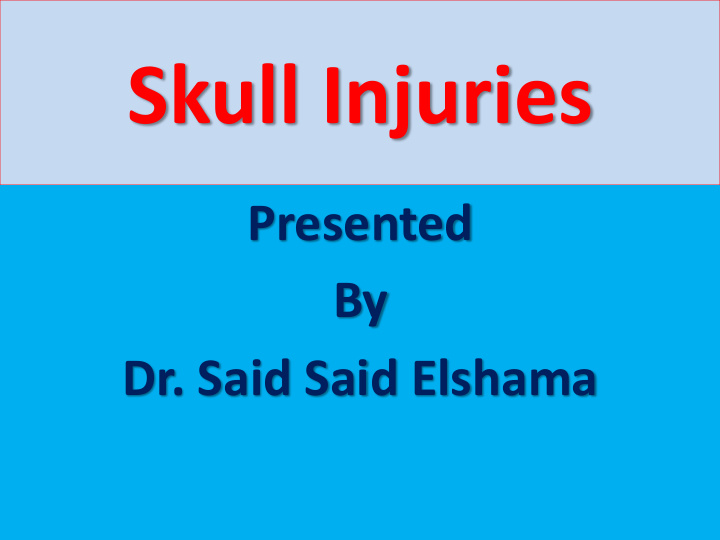



Skull Injuries Presented By Dr. Said Said Elshama
Types of head injuries 1- Scalp injuries 2- Skull injuries (Fractures) 3- Intra – cranial injuries ( Brain ) • Definition • A skull fracture is a break in one or more of eight bones of the cranial bones (skull) as a result of trauma.
Factors affecting the types of skull fractures 1- Momentum of the force (Severity of the force) 2- Size of the striking surface (Area of contact) 3- Head is supported or not (Movement of skull) 4- Type of the causative instrument (blunt , sharp)
Types of Skull Fractures 1- Fissure Fracture 2- Diastatic fracture 3- Depressed Fracture 4- Comminuted Fracture 5- Cut Fracture 6- Ring Fracture 7- Pond fracture
1- Fissure Fracture - It is caused by a blunt object with a low momentum (heavy stick) Linear fracture (fissure)
2- Diastatic skull fracture - It is a traumatic separation of the suture (widened). - It affects newborns and infants because the suture fusion has not yet happened Diastatic fracture of sagittal suture (traumatic separation)
3- Depressed Fracture - It is caused by a heavy blunt object with a localized (small) striking surface (head of hammer) Localized depressed fracture with radiating fissures
4- Comminuted Fracture - It is caused by a heavy blunt object with a wide striking surface (wide block of wood) leading to fragmentation of skull bone Comminuted fracture with radiating fissures
5- Cut Fracture - It is caused by a heavy sharp object (grubber) leading to regular, straight, sharp, cut edges Cut fracture
6- Ring Fracture - It is caused by the force transmission from the lower parts of the body through the vertebral column (a fall from a height ) leading to a ring fracture around the foramen magnum ( inward driven due to the impact of cervical spine against skull base ). Ring fracture
7- Pond Fracture (indented) - It is a shallow, round, depressed fracture in occipital, frontal or parietal bone of infant skull . - The skull bone is thin and elastic due to the presence of greater proportion of cartilage than bone . - It is caused by a blunt object (obstetric forceps) . Pond fracture
General classification of Skull fractures Closed fracture A simple fracture where the skin (scalp)covers the fracture area . Open fracture (Compound fracture) A compound fracture where the skin is broken and bone emerges . Depressed facture - It causes the skull to indent or extend into the brain cavity. Basal fracture - It occurs in the floor of the skull, in the areas that are around the eyes, ears, nose, or back
Different types of skull fractures
Signs of Base Skull Fracture A- Anterior Cranial fossa - Black eye - blood or CSF from the nose B- Middle Cranial fossa or temporal bone - Blood or CSF from the ear - Bruises behind the ear on mastoid process (Battle's sign)
Fracture base of skull
Healing of skull fractures Healing of cranium occurs by fibrous membrane not by new bone formation leading to permanent infirmity because the brain becomes more liable to minor trauma , extreme weather and sepsis that may pass from scalp to meninges causing jacksonian epilepsy due to meningeal adhesions during the healing . The fibrous membrane develop three months after fracture and fills the defect in 12 months. Fissure is healed in three months completely.
Thank you
Recommend
More recommend